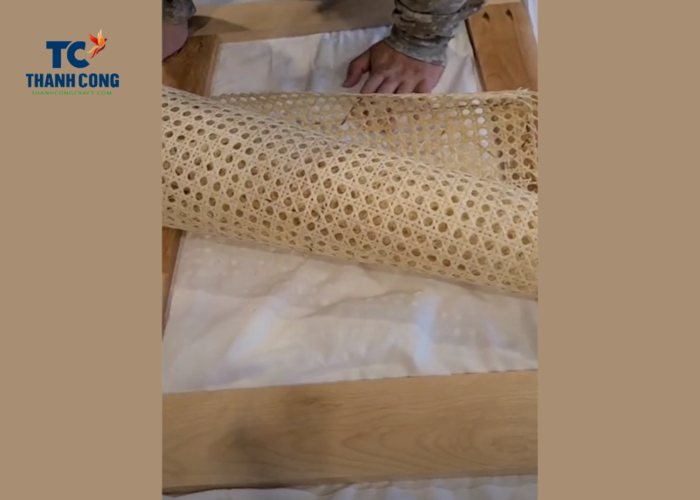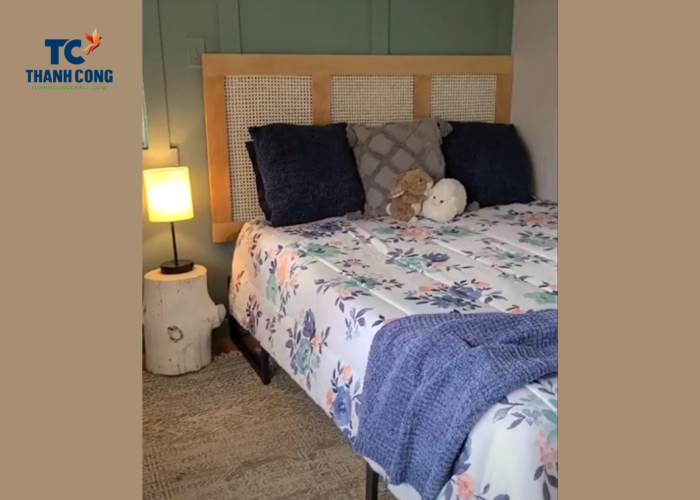A rattan headboard is a piece of furniture designed to enhance the aesthetics and add comfort to your bed. It is a popular bedroom decor element, often made from natural rattan or synthetic rattan. You can make your own (DIY) wicker headboard (bedhead) with simple materials and tools. In this article, we will guide you how to make a rattan headboard. Let’s check it out!
1. How to make a rattan headboard diy?
If you want to create a cozy and natural bedroom space, a rattan headboard can be an excellent choice. You can make your own rattan headboard with simple materials and tools.
Here are the basic steps for your reference:
Step 1: Prepare materials and tools
You will need a rectangular wood frame that matches the width of your bed, a roll of rattan cane, scissors, tape, a staple gun, nails, screws, and a drill.

Step 2: Prepare rattan pieces
Cut the rattan sheet cane into pieces with a length equal to the height of the wood frame. Cut a little extra to fold the two ends of the rattan sheet.
Step 3: Apply glue and attach rattan
Use glue to stick the rattan sheet onto the wood frame. Ensure that the cane is stretched tightly and not twisted.
Step 4: Secure with staples
Staple the cane at the intersections with the wood frame to secure it. Staple on both sides of the frame to enhance stability.

Step 5: Fold and nail rattan ends
Fold the sheet ends of the rattan cane and nail them to the wook frame. Fold them in the opposite direction of the pattern to create a symmetrical effect.
Step 6: Drill holes for mounting
Drill holes on both sides of the wood frame for wall mounting. Drill the holes at equal distances and suitable positions for wall hooks.

Step 7: Hang the headboard
Hang the rattan headboard on the wall using screws and wall hooks. Adjust it to be horizontally aligned with the bed and not tilted.

Congratulations, you’ve completed making a DIY rattan headboard. You can further decorate the headboard with details such as pillows, blankets, flowers, or artwork to create a bedroom space that reflects your style.
2. How to attach rattan headboard?
To attach a rattan headboard, you’ll need to prepare some tools and materials such as a drill, screws, zip ties, tape, and the rattan headboard itself. Measure the dimensions of both the headboard and the bed frame to choose a suitable headboard. Then, follow these steps:
- Place the rattan headboard against the wall behind the bed frame, ensuring that it is horizontally aligned and symmetrical with the bed frame.
- Use a pencil to mark the drilling positions on the wall, corresponding to the holes on the rattan headboard.
- Drill holes in the wall at the marked positions, then insert screws into the holes.
- Hang the rattan headboard on the screws, then tighten the screws to secure the headboard in place.
- Use zip ties to securely fasten the corners of the rattan headboard to the bed frame, preventing any wobbling or falling.
- Use tape to cover the screws and zip ties, enhancing the aesthetic appeal of the headboard.
That’s how you can attach a rattan headboard in a simple and effective way. You may refer to online tutorial videos for additional details and insights.
2. FAQs
2.1 Are rattan headboards good?
Yes, rattan headboards can be a good choice for several reasons:
- Rattan is a durable, lightweight, and pliable material that can be crafted into various styles. Creating a cool and comfortable sleeping space, as rattan has good breathability and moisture-absorbing properties.
- Adding style and personality to the bedroom, as rattan comes in various colors, patterns, and textures to choose from.
- Being easy to maintain and clean, as rattan is resistant to pests, mold, and dirt. Regular wiping with a damp cloth or regular dusting is usually sufficient.
- Being cost-effective and environmentally friendly, as rattan is a renewable material sourced from nature and requires minimal energy for production.
- Rattan headboards offer a combination of aesthetic appeal, comfort, and practicality, making them a favorable choice for individuals seeking a versatile and eco-friendly option for their bedroom furniture.
2.2 Do rattan headboards last?
The durability and lifespan of rattan headboards depend on several factors, including the quality of the rattan used, the craftsmanship, and how well the headboard is maintained. Here are some considerations:
- Quality of Rattan: High-quality rattan headboards made from sturdy and well-prepared rattan material are more likely to last longer. Inferior quality rattan or poorly processed materials may result in a shorter lifespan.
- Craftsmanship: The construction and craftsmanship play a crucial role in the longevity of a rattan headboard. A well-constructed headboard with secure joints and careful weaving is more likely to withstand wear and tear over time.
- Maintenance: Regular maintenance is essential to prolong the life of rattan furniture, including headboards. Keeping the headboard clean, avoiding prolonged exposure to direct sunlight or excessive moisture, and using protective measures can contribute to its longevity.
- Environmental Factors: The environment in which the rattan headboard is placed can impact its lifespan. Exposure to extreme conditions, such as high humidity or harsh sunlight, may accelerate wear and reduce the headboard’s durability.
2.3 How do I protect my rattan headboard?
Protecting your rattan headboard is essential to ensure its longevity and maintain its appearance. Here are some tips to help you protect your rattan headboard:
- Avoid Direct Sunlight: Prolonged exposure to direct sunlight can cause rattan to dry out and become brittle. Position your headboard away from windows or use curtains and blinds to minimize exposure to harsh sunlight.
- Control Humidity: Rattan is sensitive to extreme humidity levels. Avoid placing your headboard in overly humid or damp areas, as this can lead to mold and mildew growth. Use a dehumidifier if needed to maintain a stable environment.
- Clean Regularly: Dust and debris can accumulate on rattan, affecting its appearance. Wipe the headboard regularly with a soft, damp cloth to remove dust. Avoid using excessive water to prevent the rattan from absorbing moisture.
- Use Furniture Covers: If your rattan headboard is located outdoors or in an area exposed to the elements, consider using furniture covers. Covers can protect the headboard from rain, dust, and other environmental factors.
- Apply Protective Coatings: Consider applying a thin layer of protective coating, such as clear lacquer or varnish, to the rattan. This can add an extra layer of protection against moisture and make the headboard more resistant to wear.
- Keep Away from Heat Sources: Avoid placing your rattan headboard near heat sources like radiators, fireplaces, or heating vents. Exposure to excessive heat can lead to the drying out and weakening of rattan fibers.
- Use Cushions and Pillows: If your rattan headboard allows, consider adding cushions or decorative pillows. This not only enhances comfort but also provides an additional layer of protection for the rattan.
If you have any further questions, don’t hesitate to send thanhcongcraft an email us at info@thanhcongcraft.com or message us at WhatsApp: +84967485411. Hope to serve you soon! Best regard!


